Our second day trip from our base in Gran Canaria’s capital Las Palmas took us to Galdar and eventually to Puerto de las Nieves.

After awing at the historic and natural wonders of Galdar, we spent the rest of the day frolicking at the calm saltwater pools that rocks’n’lava have created on the outskirts of Puerto de las Nieves.
Gáldar
“Damn, that’s our bus! Run! Fast!” I don’t know what went wrong, but according to my thoroughly elaborated schedule, we had at least five minutes for the connection at Las Palmas’ city center. Well, obviously, the bus company didn’t know about it so they sent their bus earlier. Now, we are racing like crazy across the road, trying to avoid getting hit by a car. As we reach the bus, we realize that there was no reason for risking our life since there is a large and jolly group of elderly people in hiking gear, chatting and waving their walking sticks. And since they are definitely not Spanish, it takes a while till they explain to the driver where they are heading and buy their tickets, and choose their seats so that we can catch our breath.
“They are Swedish”, whispers Mimi. She studied in Malmö, hence, she recognizes the language. “It’s incredible, the whole bus is occupied by Swedes. I’ve never seen as many Swedes as here in Gran Canaria”, she keeps musing. “Apart from Sweden, obviously”, she adds. It’s true, the majority of the tourists we see around our apartment at Playa las Canteras in Las Palmas are Swedish.
The bus station in Gáldar is where we part company. The Swedes go hiking, we walk in the opposite direction towards the city center as we need breakfast.
The Cradle of Gran Canaria
While the group of Swedes came here to hike in the mountains south of the city, most people visit Gáldar for the grand history. Albeit, although tourism is growing, the city deems rather overlooked and sleepy – which in contrast to the touristy centers in Gran Canaria’s south and even to our base at the island’s capital Las Palmas can be very refreshing and charming.

As a matter of fact, Gáldar was one of the capitals of the island’s ancient kingdoms before the bloody Spanish conquest. The other one was Telde.
In 1481, Tenesor Semidan, a Canarian nobleman, was captured by the Catholic conquerors and sent to the Spanish peninsula. There he was baptized as Don Fernando Guanarteme. Eventually, he returned to his native island of Gran Canaria at the side of the warring Castilians. On the island, he managed to get his former subjects in Gáldar on his side. This way, only the Canarians of the Telde kingdom opposed the Castilian intruders.
Treason
Treason doesn’t pay off, that’s what Fernando Guanarteme had to learn the hard way. At the end of 1482, the commander of the conquerers, Pedro de Vera, took advantage of the old king’s friendship and trust and occupied the town of Gáldar. A defensive tower was built and one of the Canarian houses was quickly converted into a provisional church of Santiago.
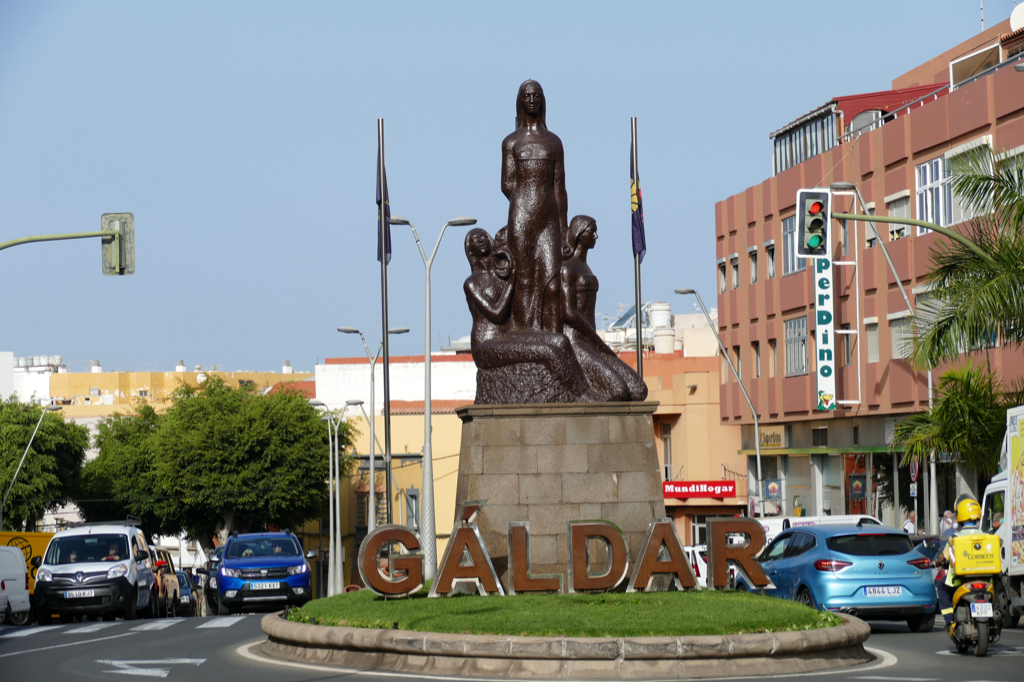
After the conquest was completed in 1483, Gáldar became one of the three districts into which the island was divided. The city evolved into one of the first modern settlements in Gran Canaria under the name of Villa de Santiago de Agáldar or Gáldar.
The wealth of good land and abundant water soon made Gáldar a prosperous enclave, however, especially the export of sugar. Eventually, the foundation of a Franciscan convent attracted several leading families, giving the old Canarian capital a stately atmosphere.
Pride
To this date, the city cherishes its ancient heritage. There is a history museum and most importantly, the museum and archeological park Cueva Pintada. Also, statues around the city are a constant reminder of Gáldar’s glorious past.

Gáldar has always been linked to the Galician Jacobean tradition. The first mass was celebrated in 1481. In 1965, the Papal Bull by Paul VI granted the city the celebration of the Holy Jacobean Year. This came with the same privileges as the Galician and Compostela Jacobean Jubilee. The pilgrimage tradition is kept up to this date, and therefore, you can spot the iconic shells all over the city.
Tour of Gáldar
As I said, we began our tour of Gáldar with a good breakfast. I’m still grateful that the jovial waiter at the Cafetería Sandro’s, located right across from the three Guayarminas, talked me out of ordering two grilled croissants. Yes, I was very hungry, but also, the one croissant he put in front of me was the size of almost three.
After we stuffed faces, we walked down the Calle Capitán Quesada, passing many outdoor restaurants and bars between beautiful buildings and on small squares.
Before we turned left into the Plaza de Santiago, Gáldar’s main square, we kinda met Don Esteban Ruíz de Quesada. This illustrious nobleman was born in Gáldar in1698 and is honored for being the investor and promoter of the Church of Santiago de Los Caballeros.
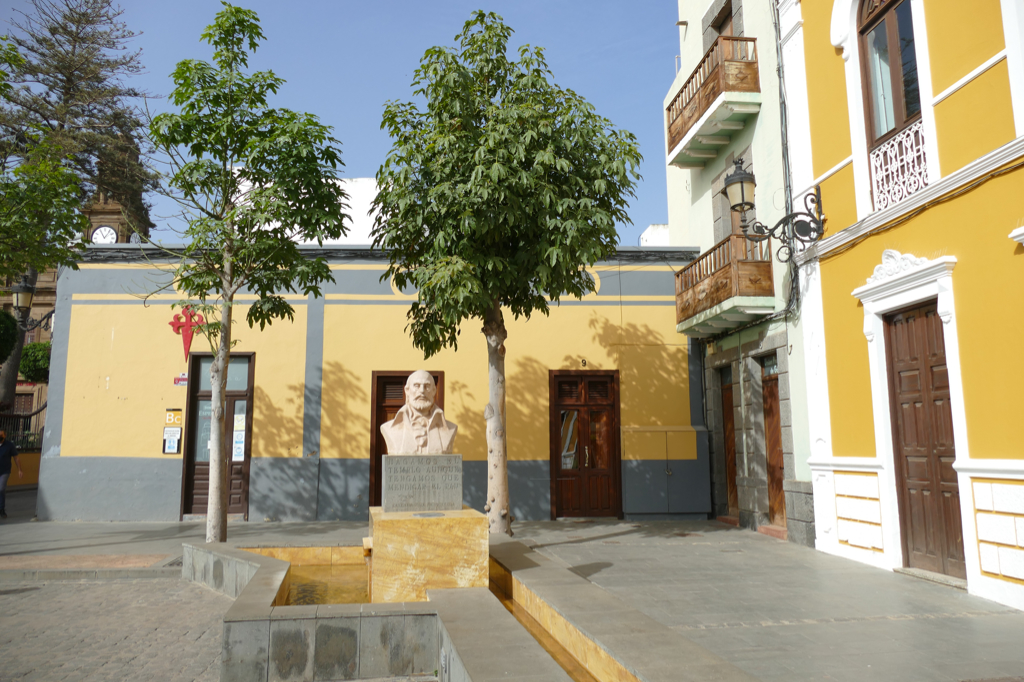
His bust, sculpted by Gáldar’s artist Juan Borges Linares, stands in front of the so-called Casino. I say so-called since it’s not a casino where you can lose all your travel budget, but a stately public building housing the Sociedad de Fomento Instrucción y Recreo, basically a community center. Therefore, if you want to take a look inside, you are welcome.
Plaza de Santiago and Parroquia de Santiago Apóstol
I’m gonna be honest with you: Obviously, you can stay an entire day in Gáldar, strolling up and down the streets and alleys, sitting on terraces, and watching time and people go by. Nevertheless, you don’t have to. You can visit the city easily in about three hours – especially since all unmissable landmarks and venues are assembled in the vicinity of the main square, Plaza de Santiago. Either right around the central park or maybe just one or two blocks apart.
Plaza de Santiago is a lovely square with pretty flowers and tall, beautiful trees. The most important building is the Iglesia de Santiago. This church is of major significance for Gáldar. Firstly, because of its beautiful architecture and artistic treasures inside.

But mainly due to its historic value for the city and all of Gran Canaria.
In 1496, a simple church building was completed in the old neighborhood of Agáldar. Also, it was the first Jacobean headquarters outside the Spanish peninsula.
In the second half of the 18th century, the population of Gáldar was constantly growing, hence, a larger house of worship was needed. Thanks to the intervention and contributions of the above introduced Don Esteban Ruíz de Quesada, the new church in a neoclassical style was finished in 1826.
On the backside of the building is the Museo de Arte Sacro de Gáldar, accessible from the Calle Fernando Guanarteme. For a general entrance fee of 5 €uros, it can be visited from Tuesday to Friday from 10 a. m. to 1 p. m., on weekends only from 11 a. m. On Friday and Saturday, it’s also open in the afternoon from 4 p. m. to 6 p. m.
El Drago de Gáldar
One of Gáldar’s most unique landmarks is actually a tree. As a matter of fact, the Drago de Gáldar is located in the tiny courtyard of the tourist information at the southeast corner of the Plaza de Santiago. Supposedly, it dates back to 1718, which makes it the oldest dragon tree on the island, obviously.

Since it has a perimeter of 2.5 meters and is 8.5 meters high, you have the impression it might simply blast the structures that surround it at any moment.

The Drago de Gáldar is listed as a singular tree in a catalog put together by Gran Canaria’s government. This list contains a total of 85 trees that are unique due to their size, beauty, botanical or environmental value, or their age.
Since the Drago de Gáldar is living in a house, you can visit it – free of charge – only during the opening hours of the city’s tourist information which are Monday from 8 a. m. to 1.30 p. m., Tuesday from 9 a. m. to 4.30 p. m. and Wednesday to Friday till 5 p. m. as well as weekends from 10 a. m. to 2 p. m.
Teatro Consistorial de Gáldar
As the tourist information is housed in Gáldar’s town hall, you should absolutely take a look into the Town Hall Theater once you pay the Drago a visit. It is one of the best historical theaters in the Canaries. Its current construction dates from 1912, however, its historical background must be placed in the reign of Isabel II, around 1847.

An outstanding element of the renovation in 2010 is the ceiling, painted by local yet internationally renowned artist José Dámaso. Honoring Gáldar’s history, his mural Revelora depicts some sort of an evolutionary process of fishes, birds, and humans in the shape of a vertex.
La Princesa Arminda
Just two blocks down from the theater is the city’s most important tourist magnet, namely the museum and archeological park Cueva Pintada, the painted cave. But on your way, you should pay attention to a statue at the corner of Calle Tagoror and Calle Harimaguadas. Since 2007, princess Arminda stands in this spot, looking a bit like Velazquez’s Meninas, by the way.
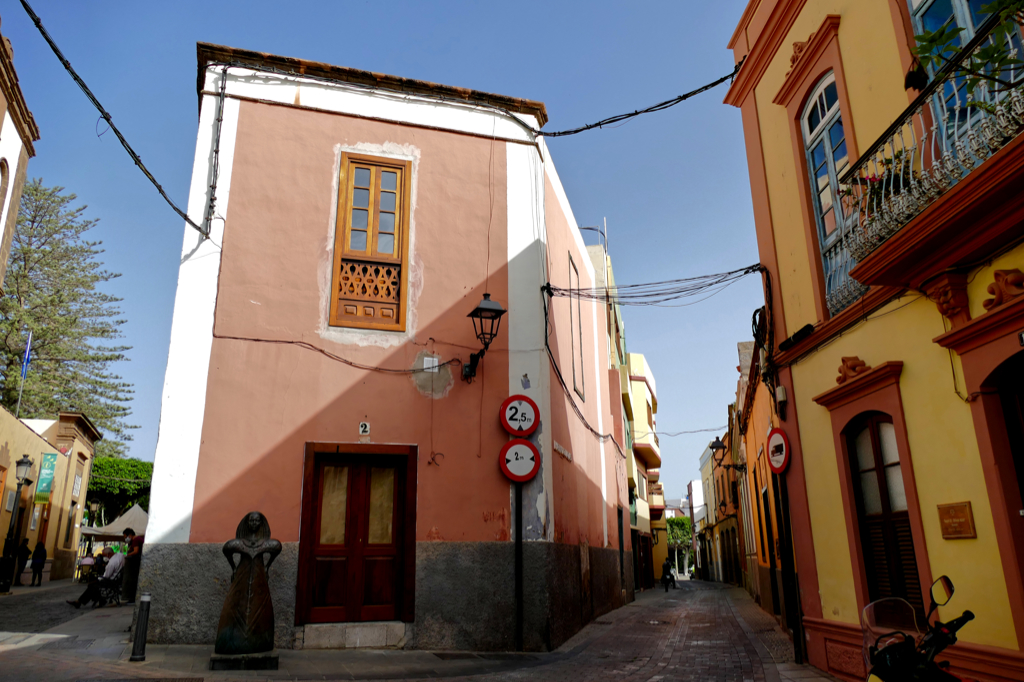
Arminda was the daughter of Guayasén Semidán el Bueno and therefore the heiress to her father’s throne. Yet, taking advantage of her young age, her uncle Tenesor Semidan took her place. I explained above that he was basically a protege of the Spanish conquerors.
After the last battles, the princess was handed over to the conqueror Pedro de Vera. This was the primary formal act of the capitulation of the Canaries in 1483.
Arminda was baptized in Las Palmas by the name of Catalina Fernández. She spent most of her life in Gáldar, however, finally retired in Agüimes. She married three times.
The museum and archeological park used various episodes of Arminda’s life to trace the faith of her people, especially in relation to the Spanish conquerors.
Museo y Parque Arqueológico Cueva Pintada
In 1873, the farmer José Ramos Orihuela discovered some strange archaeological remains, namely today’s Cueva Pintada. This ancient treasure is the center part of Gáldar’s famous museum and archeological park right in the heart of the city.
This museum is dedicated to the exhibition and also the research of the original Canarios between the 6th and 15th centuries.
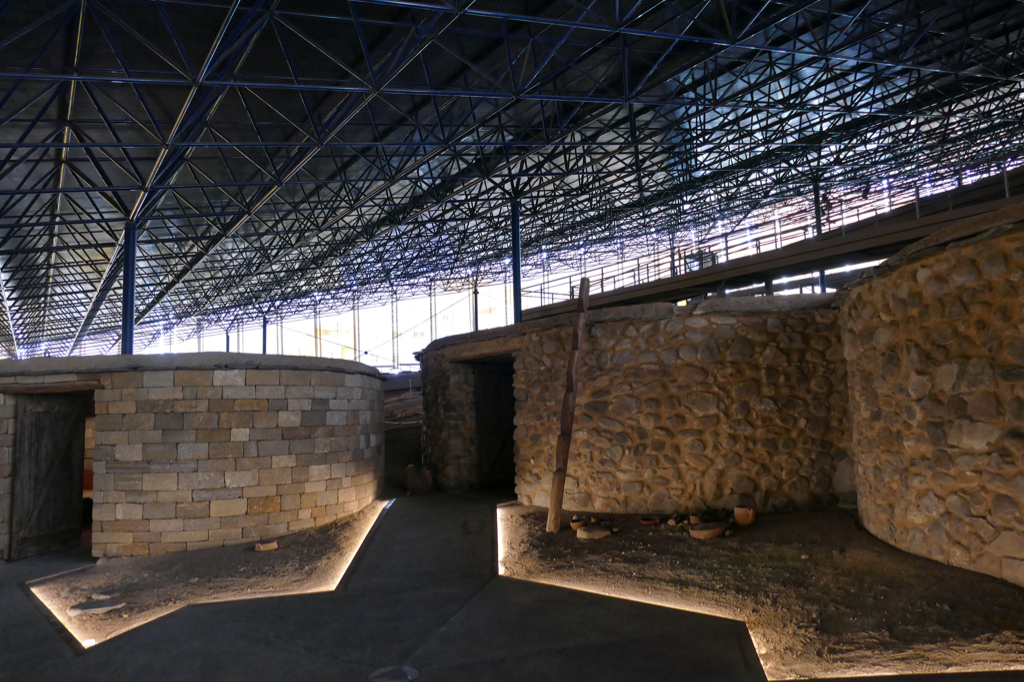
After an informative yet extremely cheesy movie on the island’s early history and Spain’s bloody conquest, visitors can visit the archaeological site on footbridges. Inside the replicas of aboriginal dwellings, you get an idea of how those people lived. There, you can also take a seat and watch explanatory videos on various topics, which is pretty neat.
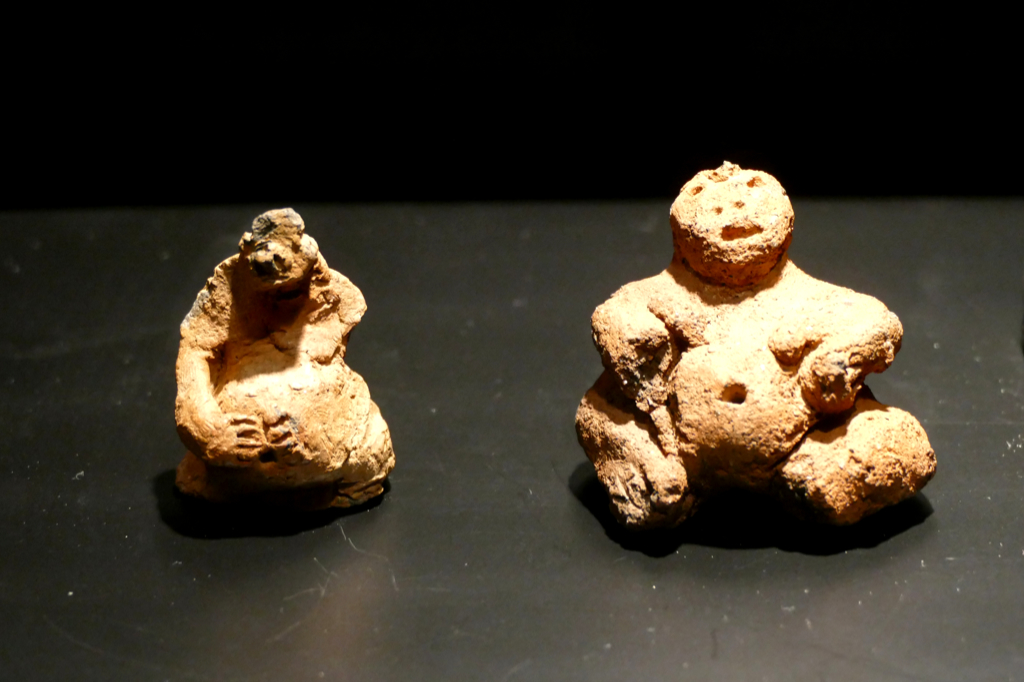
The actual Cueva Pintada is opened on a strict schedule for about ten minutes to protect the delicate paint. Taking pictures is strictly forbidden.
The paintings are geometric shapes made from clay in three colors. The most common motif is a square divided into two triangles. It is believed that the Canarios painted those geometrical patterns in the 7th century. The cave was buried during the conquest in the 15th century and had been forgotten until that lucky farmer found it about 400 years later.
The Museo y Parque Arqueológico Cueva Pintada can be visited between October and May from Tuesday to Saturday between 10 a.m. and 6 p.m., Sundays, they open only at 11 a. m. From June to September, they are open Tuesday to Saturday between 10.30 a.m. and 7.30 p.m. and Sundays from 11 a.m. till 7 p.m. The general admission fee is 6 €uros.
Going Public
Gran Canaria’s interurban bus system is great, however, you cannot expect a coach to pass every ten minutes. As we finish our tour of the museum, we have less than fifteen minutes to catch the bus to Puerto de las Nieves at the closest bus stop Huerto Nuevo. Hence, we pace down a winding street and get to the corner where the bus is supposed to stop about two minutes before the next bus is scheduled. Great timing.

We stand at a corner, it’s noon, and there is no shade. Cars passing by, drivers are looking at us with curiosity. Then the bus arrives.
Sadly, he’s heading in the opposite direction.
I check the small timetable on the wall again. Then I check the connection on Google maps. Everything should be a-o-kay.
So we keep waiting. In the sun. Being the bypassers’ entertainment.
Ten minutes later, I decide that there is something wrong and waiting any longer doesn’t make sense. We start walking uphill towards Gáldar’s main station. And as we are about 50 meters from the stop at the corner, the stupid bus approaches – and of course, the driver ignores my waving and shouting and continues undisturbed to Puerto de las Nieves.

And while the buses don’t go every ten minutes, they still go every half an hour so that we have enough time to make it to the main bus station and take it from there.
A Wild Ride
When we get to the main bus station, we have to wait only for a couple of minutes, and then the bus to Puerto de las Nievas comes. As a matter of fact, it takes less than half an hour to get from Gáldar to Puerto de las Nieves and yet, the young bus driver achieves that for Mimi, it’s thirty minutes of pure torture. She tends to suffer from motion sickness, and this whippersnapper drives as if we were in a bumper car on a fairground.
He accelerates like a maniac just to brake really abruptly just after a couple of seconds. He cuts the turns as if we’re on a race track. And then he accelerates again. But now he has to brake really hard. It’s disturbing and stomach-wise also upsetting. To top things off, he loses his way so that a young lady has to guide him back on track.
“We’re in Agaete now. From here it’s only two kilometers to Puerto de las Nieves – if he doesn’t lose his way again. Do you wanna rather walk from here?” I offer Mimi a valid alternative to this stomach-turning adventure. She weakly shakes her head no, staring straight ahead, trying to keep her stomach at bay.
Puerto de las Nieves
By the time we get to Puerto de las Nieves, Mimi feels really sick and exhausted and needs a break. Fortunately, there isn’t much to do in the village, anyway, so we stroll down a street and sit at a small table in front of a tiny bar and enjoy a soda.

Once poor Mimi is recovered from the crazy ride, we walk around, check out some restaurants for tonight’s dinner, and take a look at the Dedo de Dios, God’s finger sticking out of the Atlantic Ocean. Once upon a time, it was the pride of Puerto de las Nieves until a storm snapped it off in 2005. Now it rather looked like God’s molar tooth.
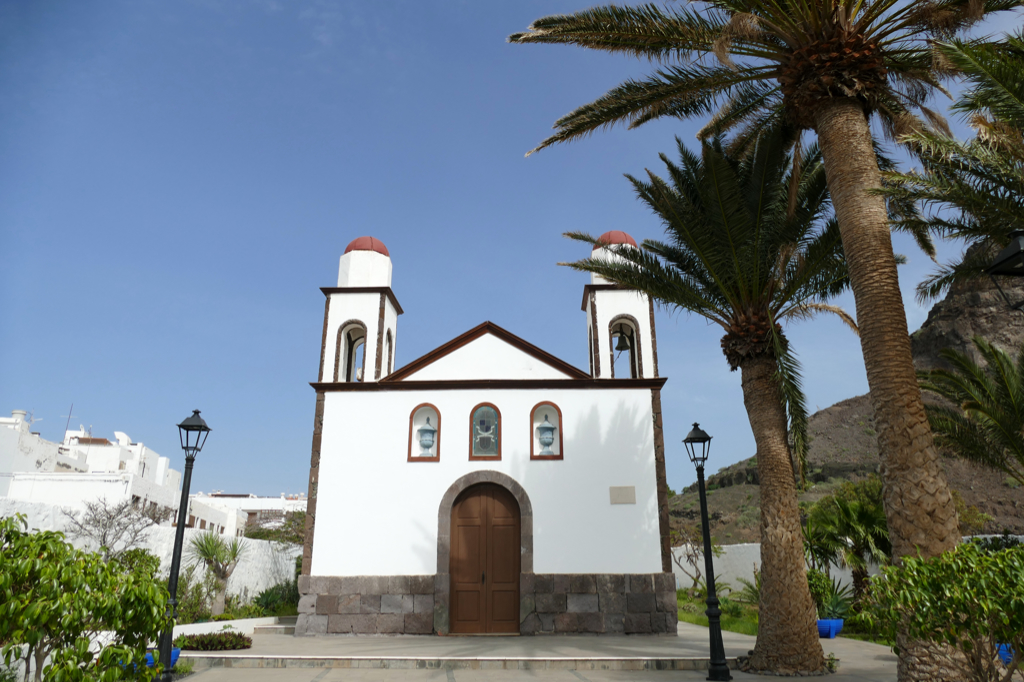
Other than that, there is basically only the small church Nuestra Señora de las Nieves to admire and some lovely old fishermen houses, many of them decorated with small wooden boats.
Going for a Swim
“Let’s check out those lava pools”, I suggest. We buy some local Gofio-icecream and walk eastwards along the shore.
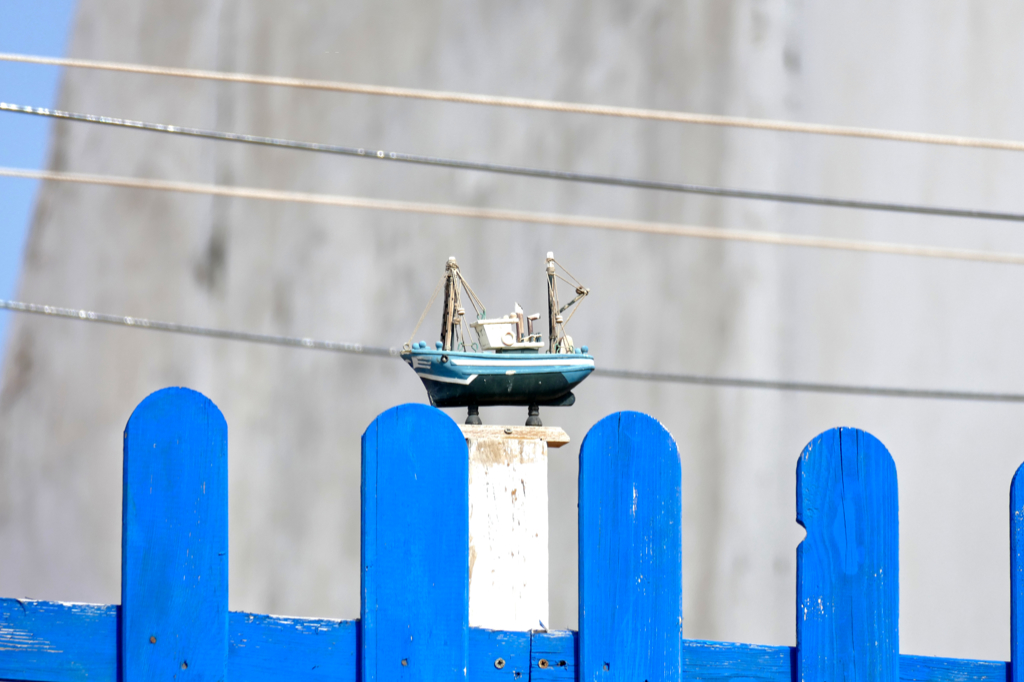
Gofio, by the way, is a powder obtained by grinding roasted cereals, very often corn. The roasted corn gives our ice cream a slight taste of popcorn. It’s quite nice and definitely very local. I like local.

We walk alongside the port and then stroll down the Paseo de los Poetas, admiring the impressive waves of the powerful Atlantic to our left and some lovely landmarks to our right.


I spot the lava pools we are heading to already from afar. Wow, I can’t wait to get there.
Lava Pools
As we come closer, I see that there are far more people than I had expected, however, for safety reasons, I prefer sharing the place with others than being there all by myself. And we actually find a small spot on a stone wall where we can place our towels and stretch out in the afternoon sun. We first observe what all the other visitors are doing and since they seem to have a great time, we also want to take a dip.
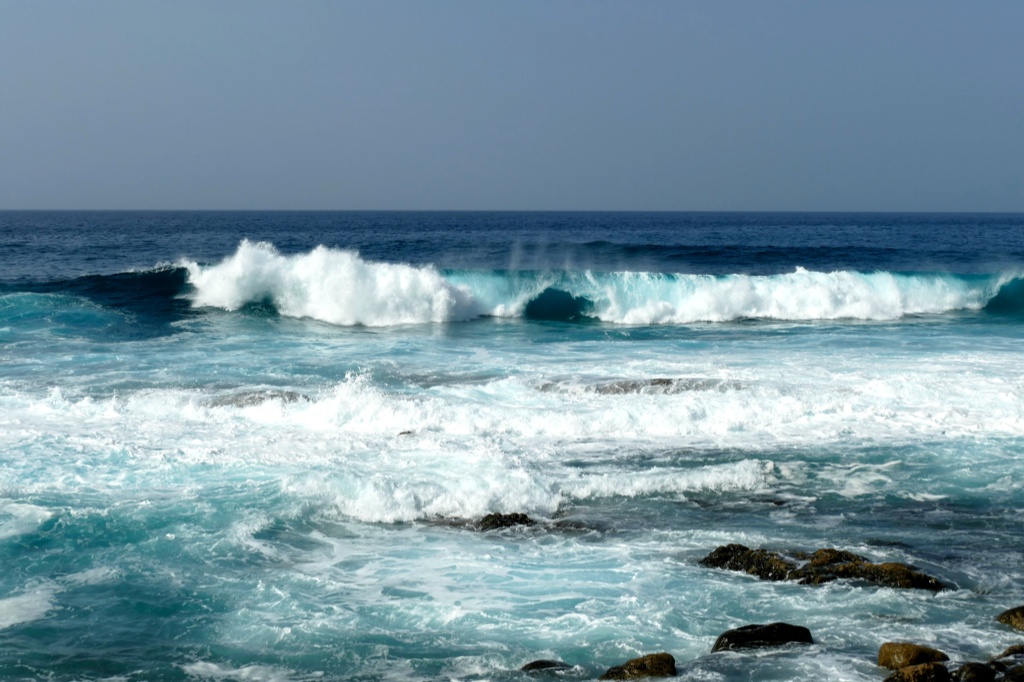
Walking on the lava ground is not easy as it is quite uneven and also a bit spikey. We keep our sandals on until we reach the steps. There, we take them off and make sure to leave them in a spot where the water from the pools doesn’t wash them into the sea. Because the water level in the pools changes according to the swell, and the later it gets, the higher the waves are crashing in.
While on Gran Canaria’s south coast the beaches can get really crowded, locals rather go to these beautiful Charcones, natural swimming pools, along the northern shores.
Designed by Nature
Nature did a great job in creating them. As there is a constant influx from the sea, the water is automatically kept fresh and clean. The waves even wash a couple of fish in so that you might wanna do some snorkeling. Also, the pools have different sizes and depths. Therefore, some are great for kids while others should rather be frequented by experienced swimmers. Only if the sea is extremely rough, you should refrain from getting in.
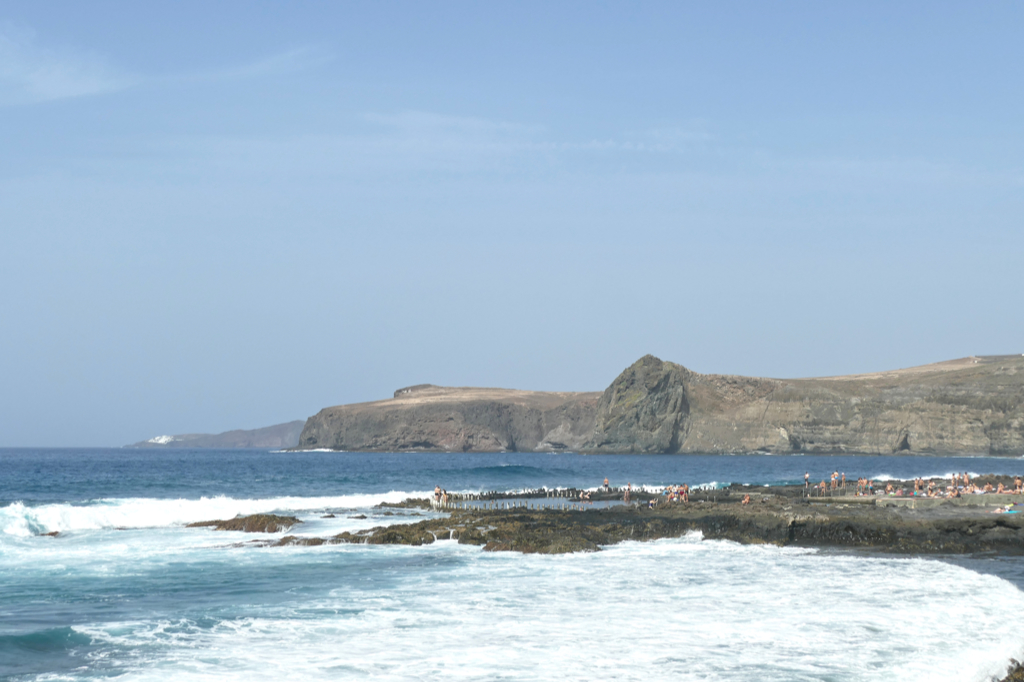
Although the visit to the wonderful Charcones is free of charge, they do have parking lots, changing rooms, toilets, and sometimes showers. Some even have some small kiosks or restaurants. Albeit, when we visited, the kiosk was closed so I’d always recommend bringing something to drink and possibly snacks.
My Tip: Another great location to safely splish-splash in lava pools is Los Charcones De Bañaderos. These facilities are located just 20 minutes by car or 45 minutes by public bus from Las Palmas de Gran Canaria. A dip here can be perfectly included in a day trip to Teror and the nearby city of Arucas.
How to Get There
Getting to Gáldar and eventually to Puerto de las Nieves from Las Palmas is easy and relatively fast. Bus #105 takes you from Estación San Telmo straight to Gáldar’s main bus station in less than an hour.
From there, you can continue to Puerto de las Nieves by either #101, #102, or #103. The latter is a direct bus which you might want to take in case you do not intend to visit also Gáldar.
You can pay the driver in cash – only with change or small bills – or by credit card if it’s equipped with NFC.
For general information and schedules, you can check out the website of Global, Gran Canaria’s interurban bus company. Global’s blue buses are connecting basically all towns and villages on the island, however, often via Las Palmas. To get your most convenient connection, you can simply type your location and desired destination into google maps, and poof – there you have it.
By the way, locals call all buses la guagua, not only those of Las Palmas’ eponymous regional bus company.
Crossing the Atlantic
While Puerto de la Luz in Las Palmas is the main port of Gran Canaria, it’s faster to take a ferry to Puerto de las Nieves when you are coming from Tenerife – and vice versa, obviously. The trip takes a bit under 1.5 hours but costs almost 65 €uros.
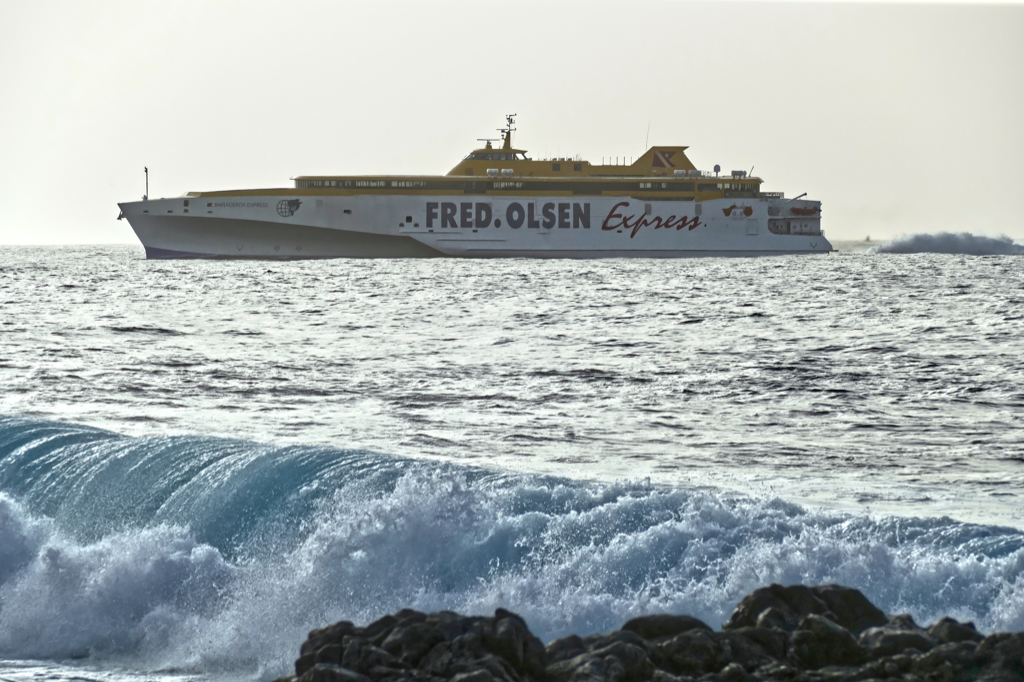
Hence, taking the ferry is not necessarily cheaper than going by plane. However, it is a more eco-friendly way of travelling. Also, it is the only option if you have to take your car across the sea.
If you’re on a flexible schedule, you should check thoroughly the prices at different times of the day as they can differ. Also, just like the airlines, the ferry companies grant residents of the Canary Islands a considerable discount.
By the way, the Fred. Olsen company has its own shuttle service between Las Palmas and Puerto de las Nieves. It’s free for their passengers, hence, you don’t have to worry about buses.
Where to Eat
When planning our day trip, we decided to stay at Puerto de las Nieves for dinner. And although some stupid clouds ruined the sunset, dining next to the beach was just wonderful.

The entire Calle Nuestra Señora de las Nieves is lined with restaurants. We opted for the Restaurante Dedo De Dios at the end of the street right next to the city beach. The location couldn’t be better, and their prices were very competitive. However, although Spain has these crazy mealtimes, at 7 p. m., we were the last guests they allowed to order food as they were closing. This might be because we were there during the off-season and also in the aftermath of the pandemic. Therefore, I suggest you check out your dining options as soon as you get to Puerto de las Nieves, this way you can plan your visit accordingly.
For a quick snack and a refreshing drink, I recommend Meson del Bocadillo at the corner of Calle Antón Cerezo simply because they are so super friendly.
Where to Stay
If you are looking for accommodation in Gáldar, it’s not that easy. Also, many of the guest houses are not within the city limits but in rather rural areas. Idyllic yet quite excluded. A great lodging option right behind the church is the Hotel Emblemático Agáldar*. They even have a pool in case you don’t make it to the coast on a hot day.
In Puerto de las Nieves, you can mostly rent tourist apartments if you want to spend the night. If you want a wider choice, you need to rest your head in the town of Agaete, about two kilometers inland.
Either way, you’ll certainly find convenient accommodation on this map*:
Our day trip to Gáldar and Puerto de las Nieves was only one of many amazing tours during our week on the island of Gran Canaria. To read about the others, go to this post and take your pick!
For general information on Spain, go to the main post. There, you’ll find information and tips that will make your trip much smoother and more enjoyable.
Map
This map should help you to find all the wonderful places in Gáldar….
….as well as in Puerto de la Nieves:
Clicking on the slider symbol at the top left or the full-screen icon at the top right will display the whole map, including the legend.
Pinnable Pictures
If you choose to pin this post for later, please use one of these pictures:
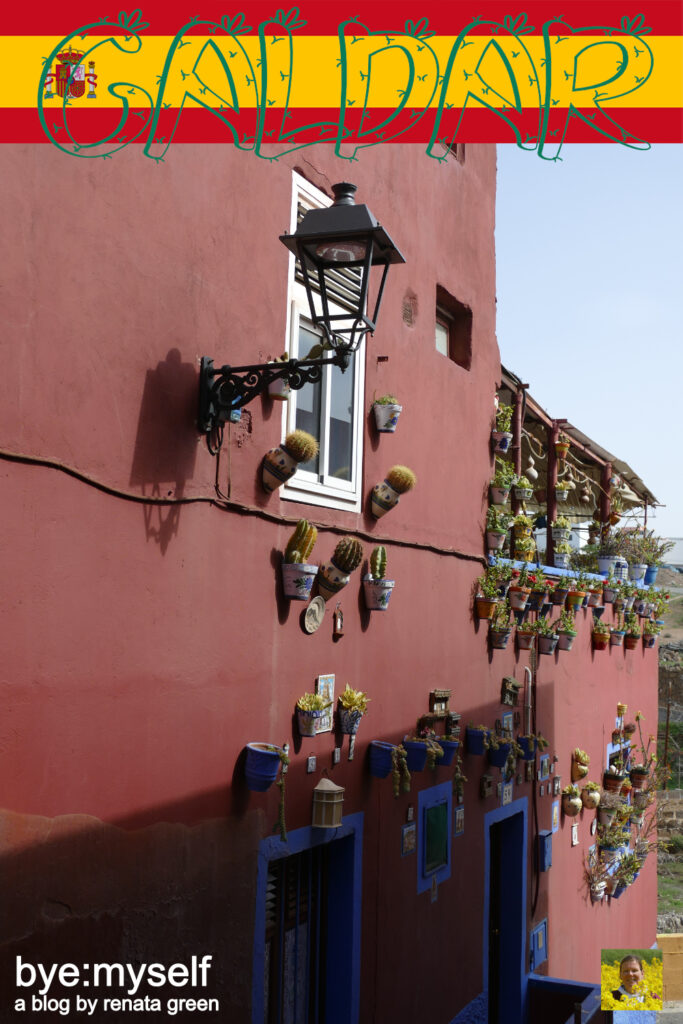

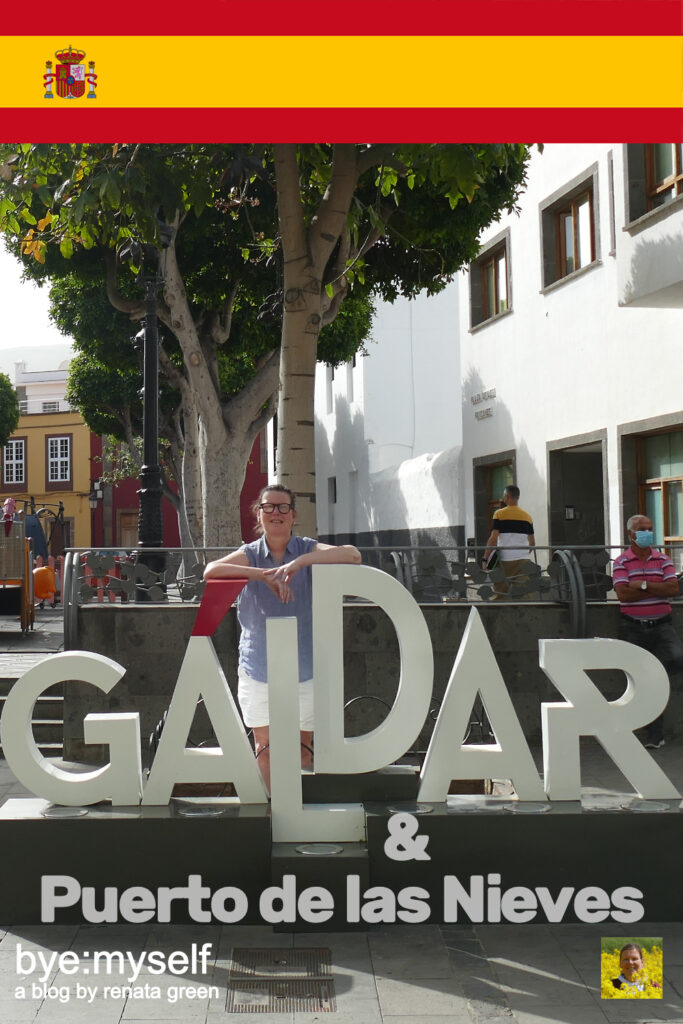



Note: I’m completing, editing, and updating this post regularly – last in October 2025.
Did You Enjoy This Post? Then You Might Like Also These:
MALLORCA – the best easy hikes
One Week in MALLORCA – Guide to the Island’s Mesmerizing Hideouts
One Day in SOLLER, DEIA, and VALLDEMOSSA – Famous Places for Famous People
ALCÚDIA – Dreamy Beach on Mallorca’s North Coast
CORRALEJO – the Aquatic Paradise of Fuerteventura
GARACHICO – ICOD DE LOS VINOS – MASCA – Touring Tenerife’s Delightful Northcoast
Seven Days in BARCELONA And Ten Reasons Not to Miss Out on a Visit
Guide to CADIZ – the Oldest City in Europe
* This is an affiliate link. Hence, If you book through this page, not only do you get the best deal. I also get a small commission that helps me run this blog. Thank you so much for supporting me!

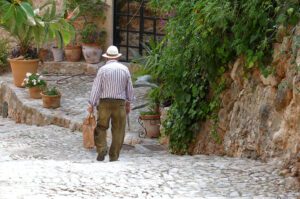
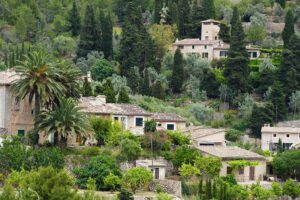




Public transit always makes for interesting stories, lol! I’m glad you caught your bus and were able to continue on with your adventures. Galdar looks like a beautiful place to visit.
It’s historically very interesting – a side of the Canaries not many tourists are aware of 🙂
It is funny but we also visited Puerto de las Nieves on our recent visit to Gran Canaria. We looked longingly at the water and really wanted a swim. But we were on a tour time table. The lava pools sound like a good option. Too bad we missed Galdar at this visit. But we know we want to go back to Gran Canaria one day.
Wow – you discovered a hidden gem 😉
It looks so beautiful ! Seeing this makes me miss travelling and miss my Portugal and spain trip!!
Yes, the Hispanic peninsula is a very nice part of Europe 🙂
oh wow! the place looks stunning! I haven’t been there but I do want now! The rocks are spectacular and the museum got me curious too. Trees are wonderful as landmarks, it always fascinates me when it happens
Yes, the landscape is amazing – most tourists, however, miss out on this part of the island 😉
Absolutely beautiful! I love how the landmark is actually a tree! What a fabulous structure to admire!
Yes, the dragon tree is truly beautiful 🙂
Your bus story seriously made me laugh because I have been in a similar situation so many times! I lived in Chicago and would frequently “run” to catch my bus that I didn’t realize had just stopped at a red light.
Yes, travelling by public transport is the world’s last great adventure 😀
I loved your funny story about running for the bus in the beginning. Then I was drawn in by the human figures in the spiral. It immediately reminded me of a creepy anime story my teen gave me to read which caused me to become obsessed with spirals for a few weeks afterward.
We had a fantastic day – apart from the rollercoaster ride on the public bus 😀 😉